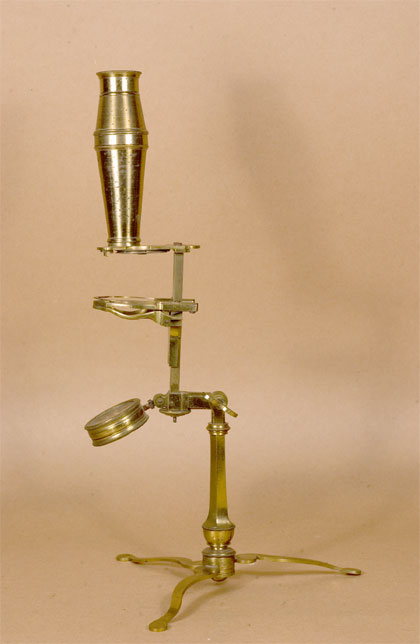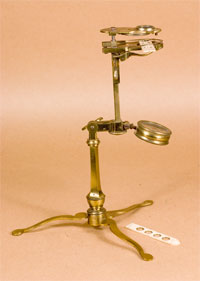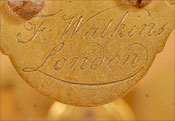 |
|||||
 |
 |
||||
 |
|||||
 |
 |
||||
Watkins Double Microscope (No. 42 ) |
|||||||||||
 |
Age: c1750 Made by: Francis Watkins Made in: England |
||||||||||
 |
|||||||||||
|
This microscope can be used as a single-lens magnifier
|
|||||||||||
 |
|||||||||||
 |
|||||||||||
|
Imaging
|
|||||||||||
|
This Watkins instrument in the Golub Collection is an all brass compound microscope supported on a curved, folding, brass tripod base, which screws to the bottom of the hexagonal brass pillar. At the top of the pillar is a hinge and limb. The limb supports a trapezoidal shaft, off of which extend the components of the microscope (mirror, stage, microscope body). The body-tube screws into a transverse arm attached to the top of the shaft. This arm supports a rotating holder containing seven objective lenses. By removing the body tube from this objective holder, the instrument also may be used as a simple magnifier. The sample stage has two slide mounts. On the top is a spring holder that is fixed to the stage and secures standard 1mm thick slides. There is a curved, spring-loaded lever below the stage that holds larger or thicker sample preparations. Coarse focus is set by positioning this stage along the trapezoidal support shaft. Fine focus is set by rotating a knob at the base of the shaft, which then moves the objective holder via a threaded rod (through the center of the shaft). The optics are characteristic of the era, and consist of three lenses: Eyepiece, Field Lens, and Objective. Magnification ranges from approximately 25 to 400x. There are several accessories included with this instrument, including two Lieberkuhn reflectors, a fish plate, live boxes, forceps, phials, and a number of prepared samples in ivory slides. The instrument can be dismantled and enclosed in its own small wooden case. The case is covered in black shagreen and lined with turquoise velvet. Francis Watkins (c1723–1785) was an optician located on 5 Charing Cross, London from 1747 to 1784. His first apprenticeship was in 1737 with Nathaniel Adams. Later, as Master Optician, Watkins took as apprentices Henry Pyefinch and Addison Smith. Pyefinch went on to make his own instruments, and Watkins formed a partnership with Smith. Watkins & Smith (1764–1774) sold microscopes, barometers, telescopes, thermometers, hygrometers, and other instruments. Watkins published a 98-page booklet in 1754 entitled "L'Exercise du Microscope... Londres Imprimé pour Francois Watkins Opticien, a Charing Cross, 1754." This was the first published description of a microscope that had all of its components supported by a hinged pillar*. The microscope exhibited here shows this construction. The hinge allows the instrument to be inclined to any angle. Microscopes of the 18th century often were used to view aquatic organisms (e.g., Hydra), thus were required to incline to a horizontal position. The hinged support pillar allowed this. A hinged support was highly regarded at the time and a number of other microscope makers adopted the Watkins idea. Benjamin Martin replaced an earlier ball-and-socket with a hinge in his instrument, and Adams incorporated the hinged support pillar in "Prince of Wales" microscope; all around the same era. *In this book Watkins also described the Cuff microscope. |
|||||||||||